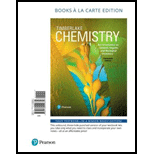
To determine:Match the following physical and chemical properties with potassium chloride, KCl, used in salt substitute, or butane, C4H10 used in lighters:
- Melts at -138 oC
- Burns vigorously in air
- Melts at 770oC
- Contains ionic bonds
- Is a gas at room temperature
Answer to Problem 11.41UTC
Solution:
- Melts at -138 oC:Physical property of butane
- Burns vigorously in air: Chemical property of butane
- Melts at 770 oC: Physical property of KCl
- Contains ionic bonds: Chemical property of KCl
- Is a gas at room temperature: Physical property of butane
Explanation of Solution
Physical property is the property that can be observed or measured without changing the element, like color, shape and volume. On the other hand, chemical properties are observed by changing the chemical identity of substance.
- Melts at -138 oC: Melting is change of state from solid to liquid. No chemical identity of the substance is changed.So, it is a physical property. Butane has a melting point -138 oC. So, this is a physical property of butane.
- Burns vigorously in air: Butane is a carbon containing compound, C4H10.When come in contact with air (O2), it burns to give CO2and H2O. Chemical identity of butane is changed. So, it is a chemical property.
- Melts at 770 oC: Melting is change of state from solid to liquid. At 770 oC, KCl melts. So, this is physical property of KCl.
- Contains ionic bonds: Ionic bonds are formed when a metal forming positive ion and nonmetal forming negative ion interact together. In case of KCl, potassium (K) is metal and Cl is nonmetal. So ionic bond will be form in KCl.Butane has carbon, hydrogen. Both are nonmetal, so ionic bond is not there.
- Is a gas at room temperature: Gas represents the physical state of a substance.At room temperature, butane is a gas and KCl is solid. So, this represents physical property of butane.
The properties are assigned physical and chemical on basis of their observable properties and where there is any change in the chemical identity of the substance. Melting is a physical property and -138 oC and 770 oC represent physical property of butane and KCl. Combustion and formation of ionic bonds are chemical properties.
Want to see more full solutions like this?
Chapter 11 Solutions
Chemistry: An Introduction to General, Organic, and Biological Chemistry, Books a la Carte Edition (13th Edition)
- Draw the product of the reaction shown below. Ignore small byproducts that would evaporate pleasearrow_forwardPoly(ethylene adipate) is a biodegradable polyester (shown below). Identify the type of polymerization process used in the production of this polymer.arrow_forwardPolymers may be composed of thousands of monomers. draw two repeat units(dimer) of the polymer formed in this reaction. assume there are hydrogen atoms on the two ends of the dimer. ignore inorganic byproducts pleasearrow_forward
- Draw the product of the reaction shown below. Use a dash or wedge bond to indicate stereochemistry of substituents on asymmetric centers, Ignore inorganic byproductsarrow_forwardDraw the product of this reaction please. Ignore inorganic byproductsarrow_forwardOne of the pi molecular orbitals of 1,3-butadiene (CH2=CHCH=CH2) is shown below. Please identify the number of nodal planes perpendicular to the bonding axisarrow_forward
- Draw the monomers required to synthesize this condensation polymer please.arrow_forwardProvide the correct systematic name for the compound shown here. Please take into account the keyboard options belowarrow_forwardcurved arrows are used to illustrate the flow of electrons. using the provided starting and product structures, draw the curved electron-pushing arrows for the following reaction or mechanistic step(s)arrow_forward
- Identify the 'cartoon' drawing of the acceptor orbital in the first mechanistic step of an electrophilic addition reaction of butadiene with HBr. Pleasearrow_forwardH- H H H H H H Identify and select all structures below that represent a constitutional isomer(s) of the compound shown above. H- H H H A. H H H H-C CI H H D. H H H H H H C C -H H C C H H H H B. H CI H H- C C H H H H E. H CI H C.arrow_forwardWhy doesn't this carry on to form a ring by deprotonating the alpha carbon and the negatively-charged carbon attacking the C=O?arrow_forward
 ChemistryChemistryISBN:9781305957404Author:Steven S. Zumdahl, Susan A. Zumdahl, Donald J. DeCostePublisher:Cengage Learning
ChemistryChemistryISBN:9781305957404Author:Steven S. Zumdahl, Susan A. Zumdahl, Donald J. DeCostePublisher:Cengage Learning ChemistryChemistryISBN:9781259911156Author:Raymond Chang Dr., Jason Overby ProfessorPublisher:McGraw-Hill Education
ChemistryChemistryISBN:9781259911156Author:Raymond Chang Dr., Jason Overby ProfessorPublisher:McGraw-Hill Education Principles of Instrumental AnalysisChemistryISBN:9781305577213Author:Douglas A. Skoog, F. James Holler, Stanley R. CrouchPublisher:Cengage Learning
Principles of Instrumental AnalysisChemistryISBN:9781305577213Author:Douglas A. Skoog, F. James Holler, Stanley R. CrouchPublisher:Cengage Learning Organic ChemistryChemistryISBN:9780078021558Author:Janice Gorzynski Smith Dr.Publisher:McGraw-Hill Education
Organic ChemistryChemistryISBN:9780078021558Author:Janice Gorzynski Smith Dr.Publisher:McGraw-Hill Education Chemistry: Principles and ReactionsChemistryISBN:9781305079373Author:William L. Masterton, Cecile N. HurleyPublisher:Cengage Learning
Chemistry: Principles and ReactionsChemistryISBN:9781305079373Author:William L. Masterton, Cecile N. HurleyPublisher:Cengage Learning Elementary Principles of Chemical Processes, Bind...ChemistryISBN:9781118431221Author:Richard M. Felder, Ronald W. Rousseau, Lisa G. BullardPublisher:WILEY
Elementary Principles of Chemical Processes, Bind...ChemistryISBN:9781118431221Author:Richard M. Felder, Ronald W. Rousseau, Lisa G. BullardPublisher:WILEY





